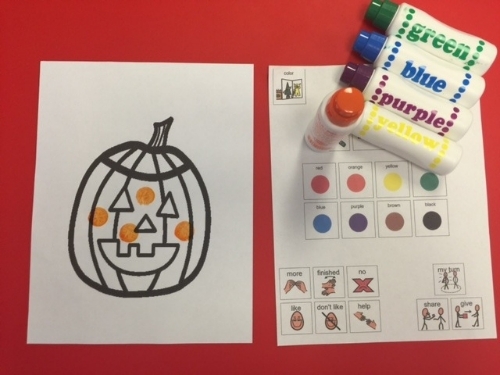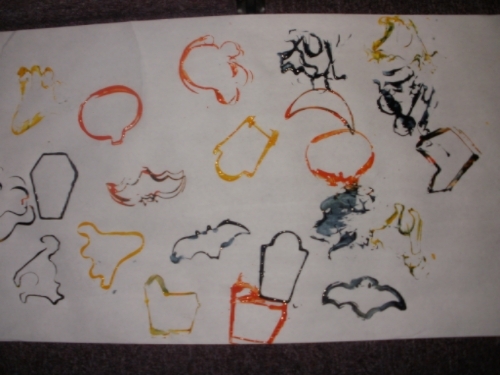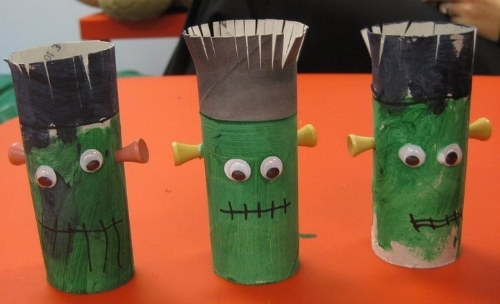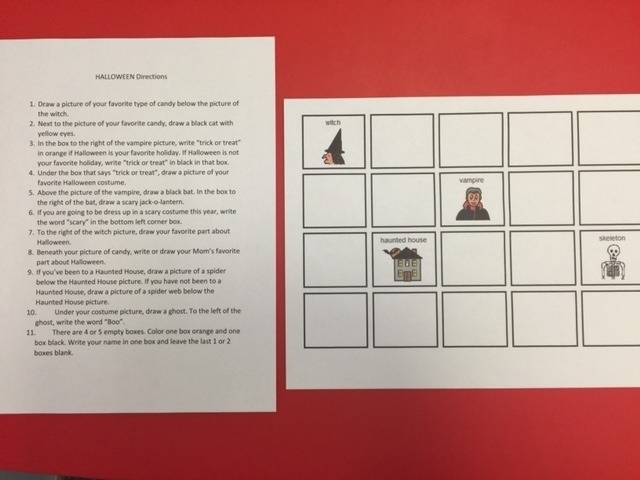Witches, monsters and skeletons……OH MY! October and Halloween are right around the corner! We LOVE Halloween at our office because it provides us with an endless amount of therapy activities for the month. Halloween is filled with such great natural language and social learning opportunities. Here are six different activities to focus on throughout the month of October to help your child or student be prepared for Halloween.
1. Books: Using Halloween-themed books are such as great way to focus on so many different skills. For our little ones it helps increase their Halloween-related vocabulary as well as all of the social routines within trick-or-treating. For our older kids they are great for character perspective taking, predicting, inferencing and much more. At our office we use the same book within therapy for two weeks. Depending on your child or client you may use the same book all month, use the same book every two weeks, or change out your book every month. Here are a few tips for reading books as well as books we LOVE!
a. Preschoolers: Some preschoolers may not be ready for a true story book....it may be difficult for them to sit or attend to a book. So when reading the books, focus on describing the illustrations in the book rather than the story. If your child is ready for the story then make it very simple. Focus on one to three word-sentences when reading or taking about the book. The goal is to familiarize them with Halloween-related vocabulary such as: ghosts, witches, pretend, candy and treats. Here are a few good books to read:
Monsters Halloween by Quentin
Maisy’s Halloween by Lucy Cousins
Five Little Pumpkins by Dan Yaccarino
Maisy’s Trick or Treat by Lucy Cousins
b. Kindergarten through second grade: For these kids you want to focus on the “socialness” of Halloween such as Halloween parties as well as planning and organization. You want to look for books that describe a great sequencing of Halloween like: thinking of what they want to do be for Halloween, finding the costume, going to a party, haunted houses, feelings, etc. Here are a few good books to read:
Froggy’s Halloween by Jonathon London
Pumpkin Eye by Denise Fleming
T-Rex Trick or Treat by Lois Gramling
There was an Old Lady Who Swallowed a Bat by Lucille Colandro
The Night Before Halloween by Natasha Wing
c. Third grade and up: With this group of children you may want to focus on finding chapter books about Halloween. A great idea is to read a chapter a night. Then have your child do something with each chapter or at the end of the week with all the chapters they have read like: drawing a picture, writing a summary , creating their own story, creating their own chapter to what they think will happen next, etc. Here are a few good books to read:
In the Haunted House by Eve Bunting
The Haunted Halloween Party (Scooby Doo) by Gail Herman
The Witch Who Was Afraid of Witches by Alice Low
2. Costumes: Costumes are such a big part of Halloween but they can be scary or uncomfortable. If costumes are difficult for your child, then put together a “Dress Up Box”! Fill this box up with items that they can wear on their heads, items they can hold, clothes they like and items that they can put on over their clothes. Here are a few great ideas:
a. Crowns
b. Microphones
c. Wings
d. Wigs
e. Jackets/shirts
f. Pajamas
g. Paper masks
h. Past years’ costumes (from your child or from siblings/friends)
Your goal is each day is for your child to begin to explore all the different dress up clothes. This will help you decide what is the best “costume” for your child for Halloween. For example, some children may not like the feel of regular costumes but they love pajamas, so instead of getting a “regular Spiderman costume” you could use Spiderman pajamas. Other children may only like to carry things, so you could dress them in their regular clothes and give them a prop to hold like a microphone and they could be a singer, weatherman, talks how host or a wand and they could be a princess, a fairy, etc. Try to spend a little time each day or week this month dressing up.
3. Activities: There are so many different activities that you can work on to help increase their understanding of Halloween. The more activities you do the better! Here are just a few of our favorites:
a. Watercolors/Finger Paint/Dot Paint/Crayons and more - Coloring Halloween Pictures
b. Color by Number Halloween Pictures -- We love the ones from Activity Village - http://www.activityvillage.co.uk/halloween-colour-by-number
c. Cookie Cutter Paints
d. Halloween Word Puzzles -- We love the ones from DLTK’s Crafts for Kids - http://www.dltk-holidays.com/halloween/worksheets.htm
e. Halloween patterns
f. Toilet Paper Roll Monsters
g. Halloween Story Writing -- We love the roll a stories from Teachers Pay Teachers - https://www.teacherspayteachers.com/Browse/Search:halloween%20roll%20a%2...
h. Halloween Following Directions
And so much more! Just remember to focus on your child’s fine motor skills and their social communication skills (requesting, asking for help, making choices, commenting and more) and have visuals ready to go!
4. Trick-or-Treating: Practice practice practice! You want to practice throughout the entire month. We practice by putting on a mask or ghost costume, walking to our door, knocking and then saying “trick-or-treat”. At our office we use a visual for our kids to understand the process as well as a visual for the phrase “trick-or -treat”.
Some kids are able to pick up on this routine very quickly and we are able to fade out the visuals; while others need the visual a little longer. No matter which area your child falls under, make sure to bring your “trick-or-treat” visual with you that night of.
5. Haunted Houses: For our older kids creating a haunted house or a haunted hallway is a wonderful activity that works on planning, organizing, working collaboratively with others (sharing ideas, being okay if your idea is not picked, listening to others’ ideas, compromising, etc.) and much more.
We like to turn this activity into a month long activity within our therapy sessions. First we talk about what are “SCARY” things and how we would create them. **For some kids we have to talk about what is “expected” and “unexpected” depending on who will be going through our haunted house/hallway. Then we create these SCARY things. We first focus on creating a list of materials needed for each activity. Then we create our “SCARY” things in a lot of different ways such as: working together, following written directions, following verbal directions from adults and peers, giving others directions on how to create it. Then we spend time decorating and going through it.
When we have individual patients, they take turns going through each other’s “haunted hallway” or their parents go through their “haunted hallway”. Within groups we either have their parents go through or we split them up into teams and they go through each other’s.
6. Pictures/Videos: Don’t forget to take pictures and videos. You can use these to talk about their Halloween as well as you can use them next year to help prepare your child for the holiday! Below is a fun template we made using stationary from Microsoft Word paired with Boardmaker. You can use pages like this make a Halloween book with your photos:
Halloween is fun but it can be an overwhelming event. Preparing your child in advance during the month of October will help set them up to succeed socially and, most importantly, will them have a good time!
~KidSpeak, LLC
The Picture Communication Symbols ©1981-2018 DynaVox Mayer-Johnson
are used under contractual agreement and were created by KidSpeak, LLC.
All rights reserved worldwide.









